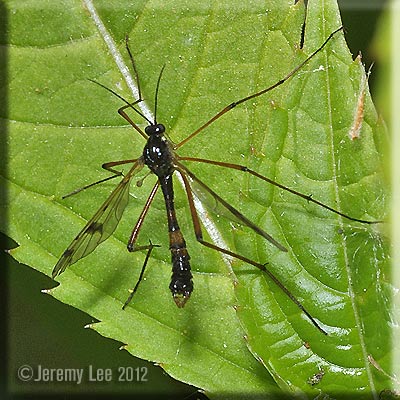
 |
|
Scientific Classifications explained » Amphibians » Ants » Aphids » Bees » Beetles » Birds » Bugs » Butterflies » Caterpillars » Damselflies » Dragonflies » Earwigs » Flies » Frog/Leafhoppers » Fungi » Galls » Grasshoppers » Harvestmen » Hoverflies » Lacewings » Ladybirds » Leaf Mines » Lichens » Mammals » Millipedes » Mosses » Moths » Sawflies » Slugs » Snails » Spiders » Trees & Shrubs » Wasps » Wild Flowers » Woodlice » Postboxes |
UK Nature > Flies > Ptychoptera contaminata

Scientific Name: Ptychoptera contaminata Common Name: Crane Fly Ptychoptera contaminata, more commonly known as a Crane Fly, is a member of a small and distinctive family which only has about seven species in it. The scientific name Ptychoptera refers to their 'folded' wings, i.e., a crease in the wing that can make the wing appear very narrow. The abdomen is mainly black with a small amount of orange, the 'thighs' are also orange in colour. The clear wings have a number of darker dots and these are larger towards the centre of the wings. They frequent water margins and marshy areas and the adults are to be seen flying from May to October. Larvae are aquatic, living in mud and litter in shallow water. They resemble long thin terrestrial 'leather jackets' with long breathing tube tails that extend to the surface of the water. Fairly frequent and widespread in England and Wales. |
|

https://www.uknature.co.uk is a website dedicated to showing the immense diversity of UK nature and wildlife. Our vast range of habitats, from lowland arable to snow covered mountains, from storm-ravaged coastlines to peaceful inland freshwater lakes and rivers, from dry, sandy heaths to deciduous and coniferous forests, all these habitats contribute to the abundance of UK nature. We have wild birds in huge numbers either residing or visiting our shores (597 recorded species as at July 2013) and we must also not forget the humble back garden with its grass lawns, flower beds filled with nectar rich flowers, shrubs and trees, all designed to attract huge numbers of insects such as bees, moths, butterflies and hoverflies; and finally the small ponds which provide safe havens for frogs, toads, newts and even slow worms and grass snakes. www.uknature.co.uk is the showcase for my personal passion, photographing uknature in all its glory. I sincerely hope you all enjoy the fruits of my labours. This site and all images contained therein is © Jeremy Lee 2004 - 2025. All Rights Reserved. Site design by Jeremy Lee. Site development & IT Support by Stuart Lee. |